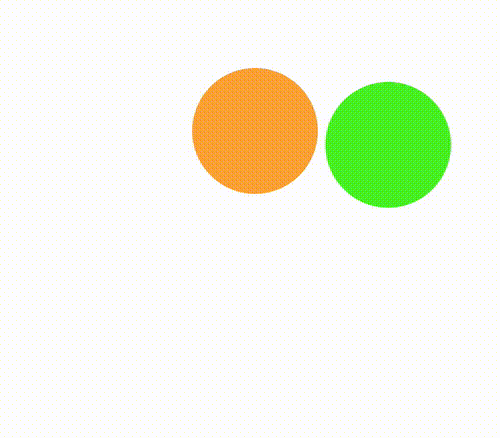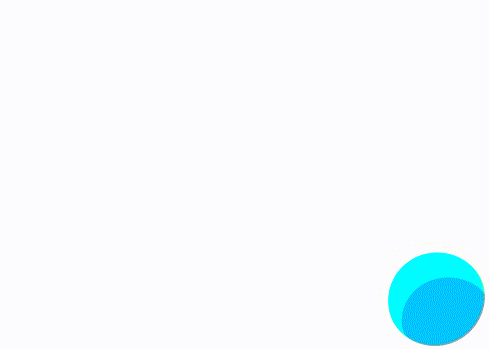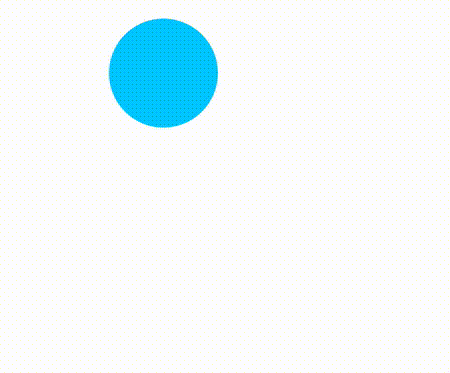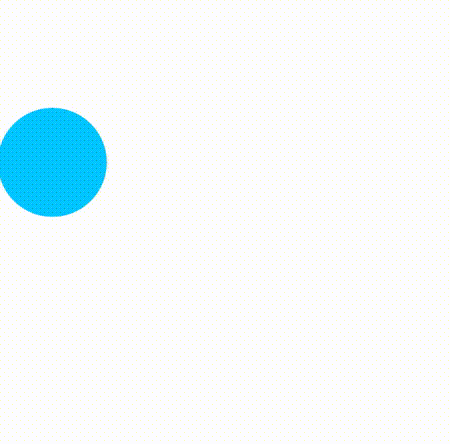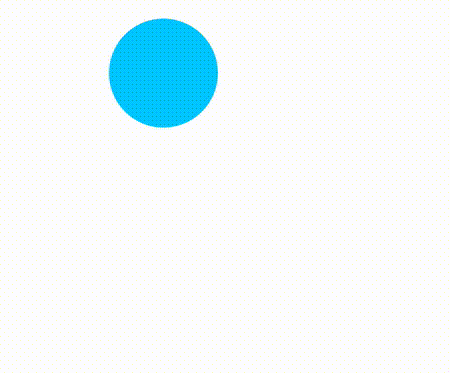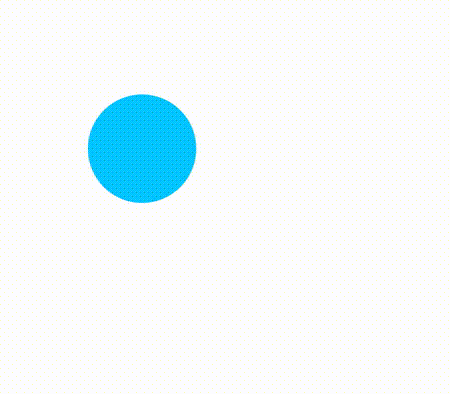本文,我们将一起学习,使用纯 CSS,实现如下所示的动画效果:
上面的动画效果,非常有意思,核心有两点:
- 小球随机做 X、Y 方向的直线运动,并且能够实现碰撞到边界的时候,实现反弹效果
- 小球在碰撞边界的瞬间,颜色发生随机的变化
嗯?很有意思的效果。看上去,我们好像使用 CSS 实现了碰撞检测。
然而,实际情况真的是这样吗?让我们一起一探究竟!
实现 X 轴方向的运动
这里其实我们并没有实现碰撞检测,因为小球和小球之间接触时,并没有发生碰撞效果。
我们只实现了,小球与边界之间的碰撞反应。不过这里,也并非碰撞检测,我们只需要设置好单个方向的运动动画,并且设置 animation-direction: alternate; 即可!
下面,我们一起来实现单个方向上的运动动画:
div {
position: absolute;
top: 0;
left: 0;
width: 100px;
height: 100px;
border-radius: 50%;
background: #0cf;
animation: horizontal 3s infinite linear alternate;
}
@keyframes horizontal {
from {
left: 0;
}
to {
left: calc(100vw - 100px);
}
}简单解读一下:
- 元素设置为
position: absolute绝对定位,利用left进行 X 轴方向的运动 - 我们让元素
div运动的距离为left: calc(100vw - 100px),元素本身的高宽都是100px,因此相当于运动到屏幕的最右侧 - 动画设置了
alternate也就是animation-direction: alternate;的简写,表示动画在每个循环中正反交替播放
这样,我们就巧妙的实现了,在视觉上,小球元素移动到最右侧边界时,回弹的效果:
如法炮制 Y 轴方向的运动
好,有了上面的铺垫,我们只需要再如法炮制 Y 轴方向的运动即可。
利用元素的 top 进行 Y 轴方向的运动:
div {
position: absolute;
top: 0;
left: 0;
width: 100px;
height: 100px;
border-radius: 50%;
background: #0cf;
animation:
horizontal 3s infinite linear alternate,
vertical 3s infinite linear alternate;
}
@keyframes horizontal {
from {
left: 0;
}
to {
left: calc(100vw - 100px);
}
}
@keyframes vertical {
from {
top: 0;
}
to {
top: calc(100vh - 100px);
}
}我们增加了一个 vertical 3s infinite linear alternate Y 轴的运动动画,实现小球从 top: 0 到 top: calc(100vh - 100px); 的运动。
这样,我们就成功的得到了 X、Y 两个方向上的小球运动,它们叠加在一起的效果如下:
颜色的变化可以忽略,GIF 录制问题。
当然,此时的问题在于,缺少了随机性,小球的始终在左上和右下角之间来回运动。
为了解决这个问题,我们需要添加一定的随机性,这个问题也要解决,我们只需要让两个方向上运动时间不一致即可。
我们修改一下代码,让 X、Y 轴的运动时长不一致即可:
div {
position: absolute;
// ...
animation:
horizontal 2.6s infinite linear alternate,
vertical 1.9s infinite linear alternate;
}如此一来,整体的效果就好上了不少,由于整个动画是无限反复进行的,随着时间的推进,整个动画呈现出来的就是无序、随机的运动:
使用 transform 替代 top、left
当然,上面的效果基本上没有什么太大的问题了,但是代码层面不够优雅,主要有两点问题:
- 元素移动使用的是
top和left,性能相对较差,需要使用transform进行替代 - 代码中 hardcode 了
100px,由于 DEMO 中小球的大小是100px x 100px,并且在动画的代码中也使用了100px这个值进行了运动终态的计算,因此如果想修改小球的元素大小,需要改动地方较多
上述两个问题,使用 transform: translate() 都可以解决,但是我们为什么一开始不用 transform 呢?
我们来尝试一下,使用 transform 替代 top、left:
div {
position: absolute;
top: 0;
left: 0;
width: 100px;
height: 100px;
border-radius: 50%;
background: #0cf;
animation:
horizontal 2.6s infinite linear alternate,
vertical 1.9s infinite linear alternate;
}
@keyframes horizontal {
from { transform: translateX(0); }
to { transform: translateX(calc(100vw - 100%)); }
}
@keyframes vertical {
from { transform: translateY(0); }
to { transform: translateY(calc(100vh - 100%)); }
}上述代码中,我们使用了 transform 替代 top、left 运动。并且,将动画代码中的 100px 替换成了 100%,这一点的好处是,在 transform: translate 中,100% 表示的是元素本身的高宽,这样,当我们改变元素本身的大小时,就无需再改变 @keyframes 中的代码,通用性更强。
我们来看看修改后的效果:
有点问题!预想中的效果并没有出现,整个动画只有 Y 轴方向上的动画效果。
这是什么原因呢?
其本质在于,定义的 vertical 1.9s infinite linear alternate 的垂直方向的动画效果覆盖了在其之前定义的 transform: translateX(calc(100vw - 100%)) 动画效果。
说人话就是 X、Y 轴的动画都使用了 transform 属性,两者之间造成了冲突。
使用 animation-composition 进行动画合成
在之前,这种情况基本是无解的,常见的解决方案就是:
- 解法一:使用
top、left替代 transform - 解法二:多一层嵌套,将一个方向的动画拆解到元素的父元素上
不过,到今天,这个问题有了更好的解法!也就是 CSS animation 家族中的新属性 —— animation-composition。
这是一个非常新的属性,表示动画合成属性,从 Chrome 112 版本开始支持。
有三种不同的取值:
{
animation-composition: replace; // 表示动画值替换
animation-composition: add; // 表示动画值追加
animation-composition: accumulate; // 表示动画值累加
}本文不会详细介绍 animation-composition,感兴趣的可以看看 MDN 的属性介绍或者 XBOXYAN 大佬的这篇文章 -- 了解一下全新的CSS动画合成属性animation-composition
这里,基于上面的代码,我们只需要再多设置一个 animation-composition: accumulate 即可解决问题:
div {
animation:
horizontal 2.6s infinite linear alternate,
vertical 1.9s infinite linear alternate;
animation-composition: accumulate;
}此时,我们就能通过一个元素,利用 transform 得到 X、Y 两个方向位移动画的合成效果,也就是我们想要的效果:
使用 steps 实现颜色切换
解决了位移动画的问题,我们就只剩下最后一个问题了,如何在碰撞的瞬间,实现颜色的切换?
这里也非常好解决,由于我们是知道每一轮 X、Y 方向上的动画时长的,那我们只需要在每次这个结点上,切换一次颜色即可。
并且,由于颜色不是过渡变换,而是直接的跳变,所以,我们需要用到 animation 中的 animation-timing-function: steps(),也就是步骤缓动函数。
对 animation-timing-function: steps() 还不太了解的,可能需要先补一补基础,可以看看这一篇文章:深入浅出 CSS 动画
举个例子,假设 X 方向上,单次的动画时长为 3s,那我们可以设置一个 steps(10) 的颜色动画,总时长为 30s,这样,每隔 3s 就会触发一次 steps() 步骤动画,颜色的变化就能够和小球与边界的碰撞动画发生在同一时刻。
那如何快速实现颜色的变化呢?利用 filter: hue-rotate() 即可快速实现颜色的变化。
理解一下下面的代码:
div {
width: 200px;
height: 200px;
background: #fc0;
}
.normal {
animation: colorChange 10s linear infinite;
}
.steps {
animation: colorChange 10s steps(5) infinite;
}
@keyframes colorChange {
100% {
filter: hue-rotate(360deg);
}
}这里,我们用 filter: hue-rotate(360deg) 的改变,实现颜色的变化,观察下面的动图,理解 steps(5) 的作用。
animation: colorChange 10s linear infinite表示背景动画的过渡变化animation: colorChange 10s steps(5) infinite,这里表示 10s 的动画分成 5 步,每两秒,会触发一次动画:
效果如下:
理解了这一步,我们就可以把颜色的变化,也一起叠加到上述的小球变化中:
div {
animation:
horizontal 2.6s infinite linear alternate,
vertical 2s infinite linear alternate,
colorX 26s infinite steps(10),
colorY 14s infinite steps(7);
animation-composition: accumulate;
}
@keyframes horizontal {
from { transform: translateX(0); }
to { transform: translateX(calc(100vw - 100%)); }
}
@keyframes vertical {
from { transform: translateY(0); }
to { transform: translateY(calc(100vh - 100%)); }
}
@keyframes colorX {
to {
filter: hue-rotate(360deg);
}
}
@keyframes colorY {
to {
filter: hue-rotate(360deg);
}
}这样,我们就成功的得到了题图中的效果:
完整的代码,你可以戳这里:Random Circle Path
应用于图片效果、应用与多粒子效果
OK,上面,我们就把整个效果的完整原理剖析了一遍。
掌握了整个原理之后,我们就可以把这个效果应用于不同场景中。
譬如,假设我们有这么一张图片:
基于上面的效果,稍加改造,我们就可以得到类似的如下效果:
div {
width: 220px;
height: 97px;
background: linear-gradient(#f00, #f00), url(https://s1.ax1x.com/2023/08/15/pPQm9oT.jpg);
background-blend-mode: lighten;
background-size: contain;
animation: horizontal 3.7s infinite -1.4s linear alternate,
vertical 4.1s infinite -2.1s linear alternate,
colorX 37s infinite -1.4s steps(10),
colorY 28.7s infinite -2.1s steps(7);
animation-composition: accumulate;
}
@keyframes horizontal {
from { transform: translateX(0); }
to { transform: translateX(calc(100vw - 100%)); }
}
@keyframes vertical {
from { transform: translateY(0); }
to { transform: translateY(calc(100vh - 100%)); }
}
@keyframes colorX {
to {
filter: hue-rotate(2185deg);
}
}
@keyframes colorY {
to {
filter: hue-rotate(1769deg);
}
}效果如下:
上面的 DEMO 是基于元素背景色的,本 DEMO 是基于图片的,因此这里多了一步,利用 mix-blend-mode,实现了图片颜色的变化。
完整的代码,你可以戳这里:CodePen Demo -- Random DVD Path
实现多粒子碰撞
OK,我们再进一步,基于上面的效果,我们可以实现各种有趣的粒子效果,如果同时让页面存在 1000 个粒子呢?
下面是我使用 CSS-Doodle 实现的纯 CSS 的粒子效果,其核心原理与上面的保持一致,只是添加了更多的随机性:
Amazing!是不是非常有趣,整个效果的代码基于 CSS-doodle 的语法,不超过 40 行。完整的代码,你可以戳这里:CSS Doodle - CSS Particles Animation
最后
总结一下,本文介绍了如何巧妙的利用 CSS 中的各种高阶技巧,组合实现类似于碰撞场景的动画效果。创建出了非常有趣的 CSS 动画,期间各种技巧的组合运用,值得好好琢磨学习。
OK,本文到此结束,希望本文对你有所帮助 :)
想 Get 到最有意思的 CSS 资讯,千万不要错过我的公众号 -- iCSS前端趣闻
更多精彩 CSS 技术文章汇总在我的 Github -- iCSS ,持续更新,欢迎点个 star 订阅收藏。
如果还有什么疑问或者建议,可以多多交流,原创文章,文笔有限,才疏学浅,文中若有不正之处,万望告知。
